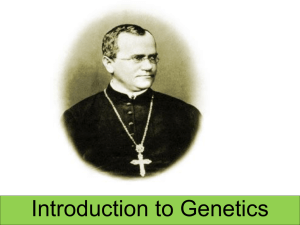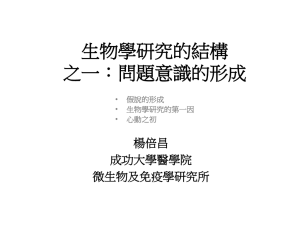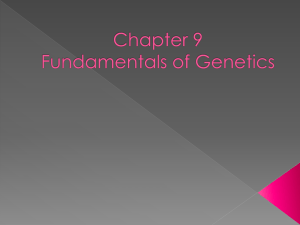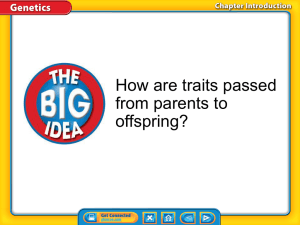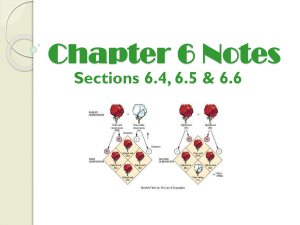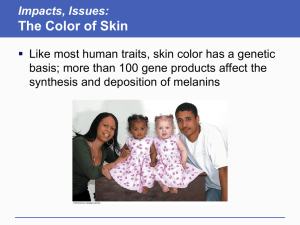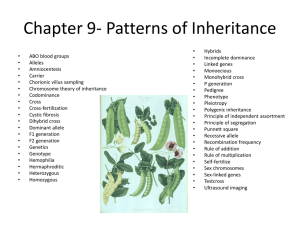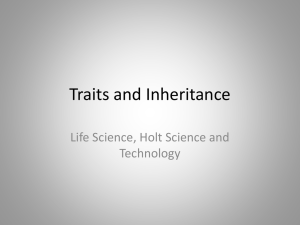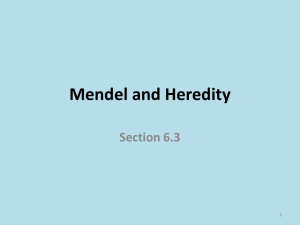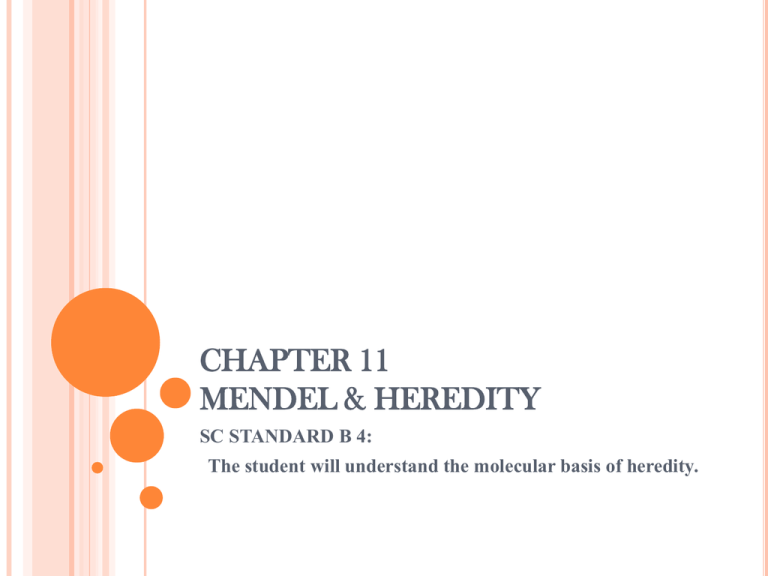
CHAPTER 11
MENDEL & HEREDITY
SC STANDARD B 4:
The student will understand the molecular basis of heredity.
ESSENTIAL QUESTION
How
does segregation of alleles
contribute to genetic variation?
ORIGINS OF HEREDITARY SCIENCE
Mendel” Breeding Experiments
Genetics: is the science of heredity &the mechanism by
which traits are passed from parents to offspring
Mendel
born in Austrian Empire (today Czech Republic) in 1822
Studied physics & mathematics @ University of Vienna
Joined monastery in 1843 where he was put in charge of
the gardens
MENDEL’S EXPERIMENTS
Mendel spent 2 years preparing his control
plants to insure they were true breeders
describes organisms that are homozygous for
a specific trait so always produce offspring
that have the same phenotype for that trait
MENDEL’S EXPERIMENTS
MENDEL’S EXPERIMENTS
crossed true breeding, purple blossomed pea
plants with true breeding, white blossomed
pea plants and all the offspring had purple
flowers
Then let the offspring self-pollinate and some
of the plants in that generation had purple
flowers & some had white
MENDEL’S EXPERIMENTS
male parts were
removed from 1st
flower
pollen taken from
male parts of 2nd
flower
pollen from 2nd
brushed onto female
parts of 1st flower
MENDEL’S EXPERIMENTS
Vocabulary:
- character: a recognizable inherited feature
or characteristic of an individual
- trait: one of two or more possible forms of a
character
~ phenotype: physical characteristics
~ genotype: genetic makeup , what alleles an
organism has
MENDEL’S EXPERIMENTS
Vocabulary:
- hybrid: the offspring of a cross between
parents that have contrasting traits
- generation: the entire group of offspring
produced by a given group of parents
MENDEL’S EXPERIMENTS
3 reasons why the garden pea plant was good choice:
1.
2.
3.
Several characters appear in contrasting
forms
These flowers can self-pollinate because
each flower has both male & female parts
Plant is easy to grow
1. Matures quickly
2. Needs little care
3. Produces many offspring
MENDEL’S EXPERIMENTS
Monohybrid Cross
MENDEL’S EXPERIMENTS
Monohybrid Cross: 3 Steps
1.
2.
3.
Produced a true-breeding
parent generation (P
generation)
Produced 1st filial generation
( F 1 generation)
Produced 2nd filial generation
( F 2 generation)
MENDEL’S EXPERIMENTS
True breeding
purple
True breeding white
MENDEL’S EXPERIMENTS
Step 2: cross
pollinated parents
F 1 generation all
purple
Self-pollinated
F 2 generation
3 : 1 purple to
white
MENDEL’S EXPERIMENTS
Mendel repeated these experiments with 7
different traits in pea plants:
For each of the 7 characters he found a similar
3 : 1 ratio of contrasting traits in the F 2
generation
MENDEL’S EXPERIMENTS
MENDEL’S EXPERIMENTS
Ratios in Mendel’s Results
F 1 generation expressed the same trait for
any of the 7 characteristics he studied
When F 1 plants allowed to self-pollinate he
always saw a 3 : 1 ratio of contrasting traits
MENDEL’S THEORY
Explains simple patterns of inheritance
2 of several versions of a gene combine &
result in 1 of several possible traits
Allele:
one of two or more alternative forms
of a gene each leading to a unique trait
MENDEL’S THEORY
Dominant: describes an
allele that is fully
expressed whenever the
allele is present
Recessive: describes an
allele that is expressed
only when there is no
dominant allele present
MENDEL’S THEORY
Law of Segregation of Alleles:
When an organism produces gametes, each
pair of alleles on homologous chromosomes
separate in Meiosis I and each gamete has
an equal chance of receiving either one of
the alleles
MENDEL’S THEORY:
LAW OF SEGREGATION OF ALLELES
MENDEL’S THEORY
GENOTYPE: a specific combination of alleles in an
individual….. the “genes” an individual has
example: AA, Aa, or aa
PHENOTYPE : the detectable trait or traits that result
from the genotype of an individual….. the “physical
appearance” an individual has
example: normal, normal, albino
MENDEL’S THEORY
GENOTYPE
DETERMINES
PHENOTYPE !
MENDEL’S THEORY
The genotype of each of the peas is ____________.
MENDEL’S THEORY
The phenotype of each of the following is _____.
MENDEL’S THEORY
Homozygous: describes an individual that carries
two identical alleles of a gene
Example: PP or pp
Heterozygous: describes an individual that carries two
different alleles of a gene
Example: Pp
MENDEL’S THEORY
Mendel’s 2nd Experiments
Dihybrid crosses: involves test crossing two
characters
Law of Independent Assortment: during gamete
formation, the alleles on non-homologous
chromosomes segregate independently
MENDEL’S THEORY
PROBLEM SOLVING:
PRODUCING TRUE-BREEDING SEEDS
Textbook
page 271
Work in table groups
Define the problem
Organize information
Create solution
Present to class
MENDEL’S THEORY
When genes are close together on same
chromosome they will rarely separate
independently so are said to be
“linked”.
MODELING MENDEL’S LAWS
Punnett Square:
a graphic used to predict the
results of a genetic cross
MODELING MENDEL’S LAWS
A Punnett Square shows all the genotypes that could
possibly result from any given cross match.
MODELING MENDEL’S LAWS
Monohybrid Homozygous Cross
Draw a Punnett Square crossing
homozygous Y (for yellow seed color) with
homozygous y (for green seed color)
What is the ratio of yellow to green seeds ?
Monohybrid Heterozygous Cross
Draw a Punnett Square crossing 2 plants
that are heteroygous for Y
What is the ratio of yellow to green seeds?
MODELING MENDEL’S LAWS
Test Cross:
used to test an individual whose
phenotype for a given characteristic is dominant but
its genotype is unknown
Individual is crossed with a known homozygous
recessive
If unknown is homozygous dominant all
offspring will show dominant phenotype
If unknown heterozygous for the trait then ½ the
offspring will show dominant phenotype & ½
will show recessive trait
MODELING MENDEL’S LAWS
Using Probability
Probability:
the likelihood that a specific
event will occur; expressed in mathematics
Probabilities are used to predict the
likelihood that specific alleles will be
passed down to offspring
QUICK LAB: PROBABILITIES: PAGE 268
Notebook: page
15
Everyone completes this:
Follow procedure
Answer analysis questions 1 - 2
MODELING MENDEL’S LAWS
Pedigree:
a diagram that shows the
occurrence of a genetic trait in several
generations of a family
Genetic Disorder:
an inherited disease
that is caused by a mutation in a gene or
by a chromosome defect
PEDIGREES
PEDIGREES
PEDIGREES
MODELING MENDEL’S LAWS
Pedigrees can help answer 3 aspects of
inheritance:
1. Sex linkage
2. Dominance
3. Heterozygocity
MODELING MENDEL’S LAWS
1.
Sex-Linked Gene
1. Gene located on either the X or Y chromosomes
2. Females have 2 X chromosomes so rarely show
the recessive phenotype; males have just 1 X
chromosome so will show the trait for a single
recessive allele for genes on the X chromosome
3. If find a trait that is more common in males than
females it is likely sex-linked
GENES ON SEX CHROMOSOMES
Sex-Linked
MODELING MENDEL’S LAWS
2. Dominant or Recessive?
If a child shows a trait and neither parent
shows the trait it is likely a recessive trait
MODELING MENDEL’S LAWS
3.
Heterozygous or Homozygous?
Recessive trait in a child shows parents
had to be heterozygous for the trait
BEYOND MENDELIAN HEREDITY
Polygenic Character:
a character
influenced by more than 1 gene
includes many characters in humans
Eye color
Skin color
Height
BEYOND MENDELIAN HEREDITY
Incomplete Dominance:
the phenotype for a
heterozygous individual is intermediate
between the homozygous dominant phenotype
and the homozygous recessive phenotype
BEYOND MENDELIAN HEREDITY
Genes that are said to have 3 or more possible alleles
are said to have multiple alleles
Example: human’s ABO blood types
BEYOND MENDELIAN HEREDITY
Codominance:
a condition in which both
alleles for a gene are fully expressed in the
phenotype
BEYOND MENDELIAN HEREDITY
Genes Affected by the Environment
Nutrients available or temperature can affect the
expression of the genotype
Examples
Some animals have fur that changes color with
the seasons
BEYOND MENDELIAN HEREDITY
During meiosis,
genes that are close together
on the same chromosome are less likely to be
separated than genes that are far apart
Genes that are close together and the traits
they determine are said to be linked (not just
sex-linked)
BEYOND MENDELIAN HEREDITY
Linked Genes

